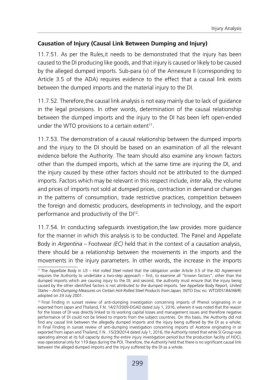Page 322 - Manual Of SOP
P. 322
Injury Analysis
Causation of Injury (Causal Link Between Dumping and Injury)
11.7.51. As per the Rules,it needs to be demonstrated that the injury has been
caused to the DI producing like goods, and that injury is caused or likely to be caused
by the alleged dumped imports. Sub-para (v) of the Annexure II (corresponding to
Article 3.5 of the ADA) requires evidence to the effect that a causal link exists
between the dumped imports and the material injury to the DI.
11.7.52. Therefore,the causal link analysis is not easy mainly due to lack of guidance
in the legal provisions. In other words, determination of the causal relationship
between the dumped imports and the injury to the DI has been left open-ended
11
under the WTO provisions to a certain extent .
11.7.53. The demonstration of a causal relationship between the dumped imports
and the injury to the DI should be based on an examination of all the relevant
evidence before the Authority. The team should also examine any known factors
other than the dumped imports, which at the same time are injuring the DI, and
the injury caused by these other factors should not be attributed to the dumped
imports. Factors which may be relevant in this respect include, inter alia, the volume
and prices of imports not sold at dumped prices, contraction in demand or changes
in the patterns of consumption, trade restrictive practices, competition between
the foreign and domestic producers, developments in technology, and the export
12
performance and productivity of the DI .
11.7.54. In conducting safeguards investigation,the law provides more guidance
for the manner in which this analysis is to be conducted. The Panel and Appellate
Body in Argentina – Footwear (EC) held that in the context of a causation analysis,
there should be a relationship between the movements in the imports and the
movements in the injury parameters. In other words, the increase in the imports
11 The Appellate Body in US – Hot rolled Steel noted that the obligation under Article 3.5 of the AD Agreement
requires the Authority to undertake a two-step approach – first, to examine all “known factors”, other than the
dumped imports which are causing injury to the DI; and second, the authority must ensure that the injury being
caused by the other identified factors is not attributed to the dumped imports. See Appellate Body Report, United
States – Anti-Dumping Measures on Certain Hot-Rolled Steel Products from Japan, (WTO Doc no. WTO/DS184/AB/R)
adopted on 24 July 2001.
12 Final Finding in sunset review of anti-dumping investigation concerning imports of Phenol originating in or
exported from Japan and Thailand, F.N. 14/27/2009-DGAD dated July 1, 2016, wherein it was noted that the reason
for the losses of DI was directly linked to its working capital losses and management issues and therefore negative
performance of DI could not be linked to imports from the subject countries. On this basis, the Authority did not
find any causal link between the allegedly dumped imports and the injury being suffered by the DI as a whole;
In Final Finding in sunset review of anti-dumping investigation concerning imports of Acetone originating in or
exported from Japan and Thailand, F.N. .15/29/2014 dated July 1, 2016, the Authority noted that while SI Group was
operating almost at its full capacity during the entire injury investigation period but the production facility of HOCL
was operational only for 119 days during the POI. Therefore, the Authority held that there is no significant causal link
between the alleged dumped imports and the injury suffered by the DI as a whole.
299

